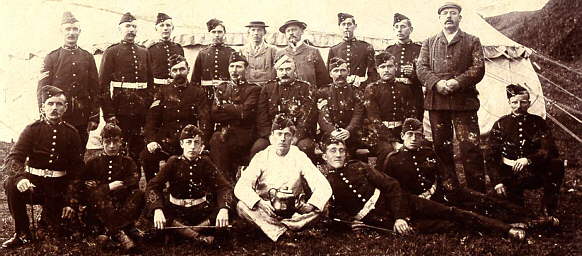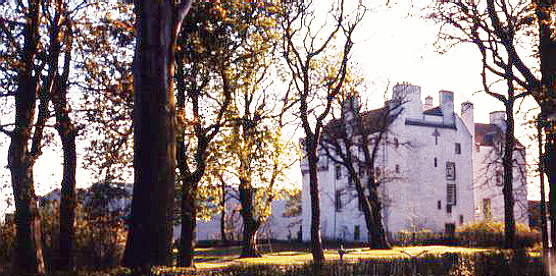 |
James Lothian Mitchell - Part 4
Site navigation - please use menu on left (click here to display it if not visible). If problems, use site map.
|
James Lothian Mitchell - Part 4 Site navigation - please use menu on left (click here to display it if not visible). If problems, use site map. |
Part 4 - The Purchase of Rossend Estate and the End of an Era
| The Volunteers
The Volunteer movement, precursor to today's Territorial Army, provided some relaxation and comradeship, as well as training, for local men including Mitchell. True to form, he was as interested in the politics of defence as in the practical aspects, and was much in favour of developing a strong voluntary component of the armed services. |
 |
|
Above - the
1st Fife Volunteer Artillery at their Brigade Camp, Kinghorn, July 1902
(Lieutenant Mitchell - middle row, second from the left) |
|
|
The Purchase of Rossend Castle and Estate
1906 drew to a close with a bitterly fought Town Council election. William Erskine, with strong backing from Mitchell, was top of the poll. One source of the bitterness was a scurrilous anti-Erskine leaflet which was circulated anonymously before the election. The distributor was eventually identified as the Burntisland Postmaster. Mitchell called on the authorities to take disciplinary action, no doubt comparing this covert act by a Crown employee with his own more restrained and open conduct while headmaster.
At the first meeting of the new Council, the three senior posts were keenly contested. Successful were John Wallace (Provost), William Erskine (Senior Bailie), and James Mitchell (Junior Bailie).
The death of James Shepherd meant that Rossend Castle and estate came on the market in July 1907. Mitchell, Erskine and Patterson saw great advantages for the town if it were to be purchased by the Town Council. Another battle ensued, with Stocks leading the opposition. At the end, the issue was decided quickly. The Town Council met at 10.30 a.m. on the 17th of July, the day of the sale, and authorised Mitchell and Erskine to bid at the auction in Edinburgh that afternoon. One can imagine these two gentlemen running from the Town Hall to the slipway, to catch the ferry to Granton.
They arrived in time to make a successful bid of, in today's terms, £180,000. Over the years, the town has certainly got its money's worth from the purchase of the Rossend estate. Let William Erskine himself, writing in 1929, catalogue the benefits in just the first 20 years of the Council's ownership:
"The primary object of the purchase was the securing of a depot to enable the cleansing department of the Council's operations to carry on at a reduced annual expenditure. This object has been gained. During the period that has elapsed since the purchase was effected, the payment of £200 per annum for the railing of the street refuse has been saved, the accumulated value of this alone being more than the price paid for the Castle and estate. At least £4,000 has been diverted from outside channels and kept within the burgh. Ground that was useless for practical purposes has been reclaimed from the bog. Space for the popular pastime of football has been provided; part of the low-lying ground has been leased as a depot for the refuse matter cast aside from the aluminium works, yielding an extra revenue to the town; an important part of the housing scheme has been built upon the western portion of the high ground at a feuing price about one half the price of feuing land in other parts of the town; extra buildings that were adjuncts of the Castle have become dwelling-houses, yielding a fair rent; and the Castle itself is still a lettable subject. The balance of the arable land is still an asset of some value so that the ghost of the 'white elephant' has been effectually scared away."
 |
| Rossend
Castle
The recent history of the castle itself is well documented. It is now once again one of the town's finest buildings, following its purchase in 1975 by the Hurd Rolland Partnership. But it certainly had its ups and downs in the years prior to that. After it was bought by the Town Council in 1907, it was let to the Misses Gold of Colinswell House, former maids of James Shepherd, and run by them as a boarding house. According to the present owners, "Weddings, functions and afternoon teas were a feature of the services and many people coming to Burntisland in connection with shipyard or aluminium works took lodgings there." But subsequent Town Councils failed to maintain the fabric, and the castle deteriorated to the extent that, in 1962, the Council of the day wanted to demolish it. The battle to save the castle raged for 13 years, until Hurd Rolland's visionary plans proved an acceptable option for everyone involved. |
|
|
An air of prosperity
The 12 months following the 1906 election saw significant changes in the west end of the High Street. The Town Hall extension opened, with the Post Office occupying the ground floor. The new Council Chamber in the Town Hall, which is now home to the Community Council and other local organisations, hosted its first meeting. Andrew Carnegie opened the Public Library. The town had a prosperous air, fuelled by the developments in the public sector. The churches were not being left behind, with the impressive new Erskine Church now occupied, and ambitious plans for the Episcopal Church. There was, however, no room for unnecessary extravagance. Although the burgh's bay horse was described as being in a dilapidated condition, the Town Council decided that it could haul the municipal carts for a year or two yet. |
The end of an era
By 1907, Burntisland was making a name for itself, and was becoming known throughout Fife as the socialist burgh.
And Mitchell had additional ideas for the Rossend estate. Some of these were recreational, such as a bowling green for working men, a swimming pool, a cricket pitch, a municipal golf course, a pleasure ground, a pier, and a museum and concert hall in the Castle itself.
He also proposed a public health measure: that the Town Council open a dairy on the Rossend estate and start selling milk. We may look askance these days, when the Labour Party is trying to outdo the Conservatives in dismantling the public sector. But in 1907 there were no controls, such as we have today, to safeguard the consumer. Milk was a staple food on which everyone was dependent, and the private sector suppliers were charging a premium price for a poor quality product.
| The Smallpox Hospital
Cases of smallpox occurred periodically throughout the area in the early 1900s. The Town Council, as the public health authority, received regular reports on the condition of the Smallpox Hospital at the Lammerlaws. On a lighter note, in May 1905 the Councillors received a complaint from the hospital caretaker, in which he asked for protection from those footballers who kicked their ball into his garden, and then used all the foul names they could think of when they saw him coming. On one occasion he had confiscated the ball, and had received a solicitor's letter claiming the cost. The Council responded as Councils often did in those days, and set up yet another committee to inquire into the playing of football at the battery ground. |
But Mitchell was leading a fragile existence, and the strain was beginning to tell. His wife was suffering from rheumatoid arthritis and needed constant nursing. She was unable to look after their daughter, who was found a temporary foster home with the local midwife, Mary Roy. His dismissal meant he had to seek employment in the cities: temporary teaching work in Edinburgh, and latterly as a law tutor in Glasgow. He also tried to establish a small printing venture in Glasgow. And he never lost his thirst for knowledge, enrolling for classes at Glasgow University in 1907.
Although he maintained a base in Burntisland - a small flat in Harbour Place - he was spending progressively less time in the town. There were also allegations that an opposing Councillor had been able to tamper with the voters' roll, and erase the name of a Mitchell supporter who was to have been a candidate in the 1907 election, thus disqualifying the supporter from standing.
Mitchell's influence was waning, and he attended his last Burntisland Town Council meeting in April 1908.
The loss of his job and career, and the enforced separation from his family, all took their toll. His health was failing, and he died in relative poverty in Glasgow on the 17th of July, 1908, at the age of 44.
His enemies had won an indirect victory. But Burntisland had lost an outstanding headmaster and civic leader. Had events turned out differently, there is no saying what he might have achieved in the wider sphere. With the death of Mitchell came the end of Burntisland's early and brave attempt at community enterprise. He had achieved much in his relatively short time on the Town Council. And his attempts to increase the accountability of the town's elected representatives and to improve standards in public life had also had a fair measure of success.
Not enough, though, to prevent Stocks engaging in blatant favouritism in 1908 when Mitchell was safely out of the way. He arranged for the Burgh Assessor to be sacked, and Robert Brown to be appointed. One can imagine the reaction these days if a new party were to form the administration in Fife Council, and then tried to replace senior officials with their pals. Cronyism is the word we now use.
A final word from John Patterson, that man of unwavering integrity, writing in August 1908: "The late Bailie Mitchell's record as a Councillor will stand inspection and has been for the good of the community, and will be remembered in years to come, long after the names of those who have grown old in the service, and can point to nothing of real public worth or importance, have been entirely forgotten."
James Mitchell's final resting place is Lambhill Cemetery in Glasgow, rather than his beloved Burntisland. His grave remained unmarked until 1991, when a simple headstone was erected.
 |
| Sources: The principal sources for this article were the minutes of Burntisland School Board; Burntisland School log; the minutes of Burntisland Town Council; contemporary issues of the Fifeshire Advertiser; William Erskine's "Glimpses of Modern Burntisland" (published in 1930); and the author's personal archive. |
Please click here to return to part 1 of the article.
© Iain Sommerville 1999
Webpage by Iain Sommerville;
Help on bookmarking this page.